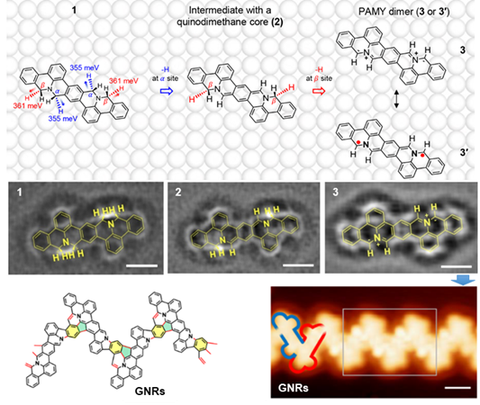02.11.2022
Selective activation of four quasi-equivalent C–H bonds yields N-doped graphene nanoribbons with partial corannulene motifs
Selective C–H bond activation is one of the most challenging topics for organic reactions, which has been referred to as “chemistry’s ultimate prize”. Introducing heteroatoms, such as nitrogen and sulfur atoms into the organic skeleton, is an established approach to activate vicinal C atoms such as ortho C atoms. However, this strategy lacks selectivity among equivalent/quasi-equivalent ortho C atoms in heterocycles. In this regard, the step-wise, kinetic activation of equivalent/quasi-equivalent of ortho C(sp3) atoms would be a major achievement in the field. The researchers from the group of Prof. Xinliang Feng in collaboration with the group of Prof. Hong-Jun Gao and Prof. Shixuan Du (Chinese Academy of Sciences, Beijing, China) successfully achieve the selective activation of four quasi-equivalent C–H bonds in a specially designed nitrogen-containing polycyclic hydrocarbon (N-PH). Density functional theory calculations reveal that the adsorption of N-PH on Ag(100) differentiates the activity of the four ortho C(sp3) atoms in the N-heterocycles into two groups, suggesting a selective dehydrogenation, which is demonstrated by sequential-annealing experiments of N-PH/Ag(100). Further annealing leads to the formation of N-doped graphene nanoribbons with partial corannulene motifs, realized by the C–H bond activation process. This work provides a route of designing precursor molecules with ortho C(sp3) atom in an N-heterocycle to realize surface-induced selective dehydrogenation in quasi-equivalent sites.
This article featured in a Nature Communications Editors’ Highlights webpage of recent research called “Materials science and chemistry”, see https://www.nature.com/collections/wtpqpqpgwd
Reference: Yixuan Gao, Li Huang, Yun Cao, Marcus Richter, Jing Qi, Qi Zheng, Huan Yang, Ji Ma, Xiao Chang, Xiaoshuai Fu, Carlos-Andres Palma, Hongliang Lu, Yu-Yang Zhang, Zhihai Cheng, Xiao Lin, Min Ouyang, Xinliang Feng, Shixuan Du, Hong-Jun Gao. Nature Communications, 2022, 13, 6146.
Acknowledgments: We acknowledge the financial support from the National Natural Science Foundation of China (No. 61888102, 61622116 and 11974403), National Key Research and Development Program of China (No. 2018YFA0305800 and 2019YFA0308500), the Strategic Priority Research Program of Chinese Academy of Sciences (No. XDB30000000), the German Research Foundation (DFG) with EnhanceNano (No. 391979941), the CAS Project for Young Scientists in Basic Research (YSBR-003), the CAS Frontier Sciences and Education grant (No. QYZDBSSW-SLH038), the K. C. Wong Education Foundation and the CAS Pioneer Hundred Talents Program. Z.H. Cheng was supported by the Fundamental Research Funds for the Central Universities and the Research Funds of Renmin University of China (No. 18XNLG01). Part of the research was performed in the Key Laboratory of Vacuum Physics, Chinese Academy of Sciences. Computational resources were provided by the National Supercomputing Center in Tianjin Municipality, China.
